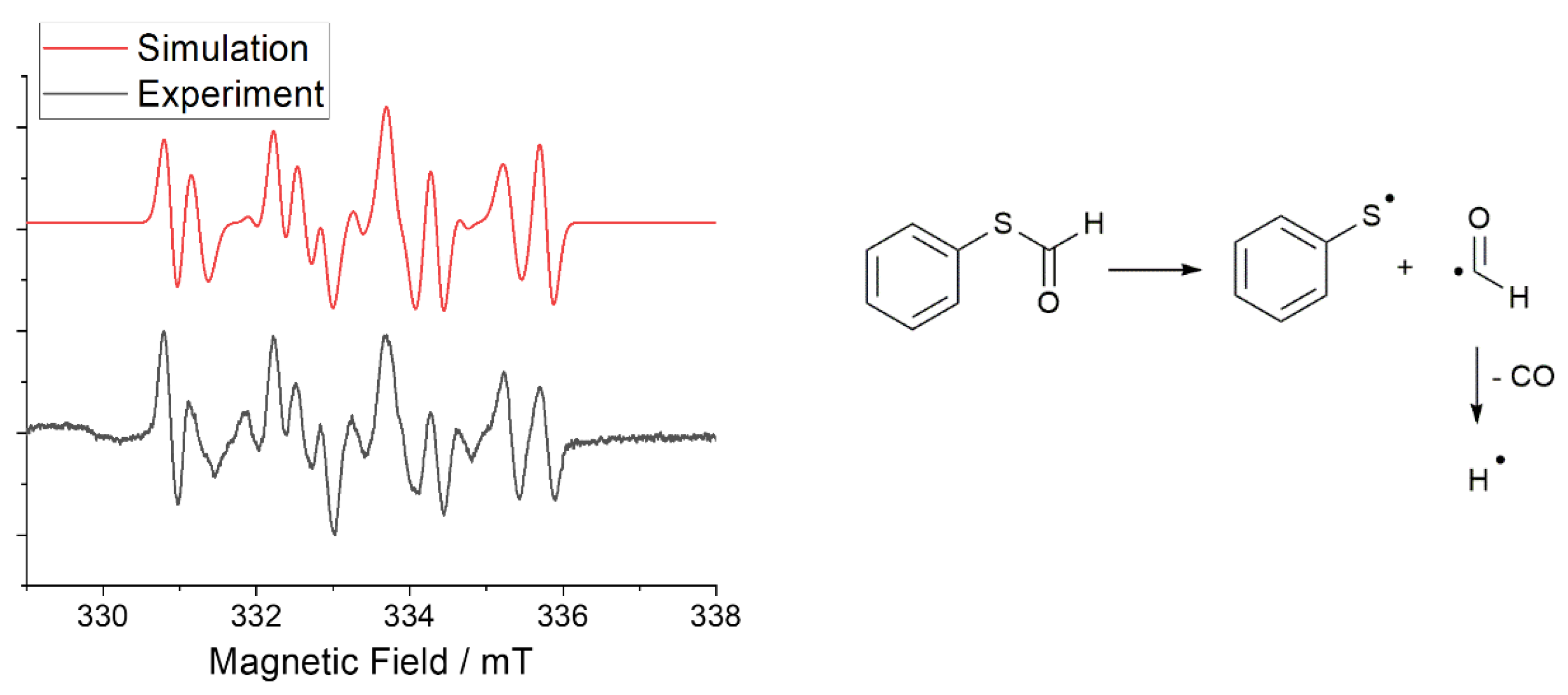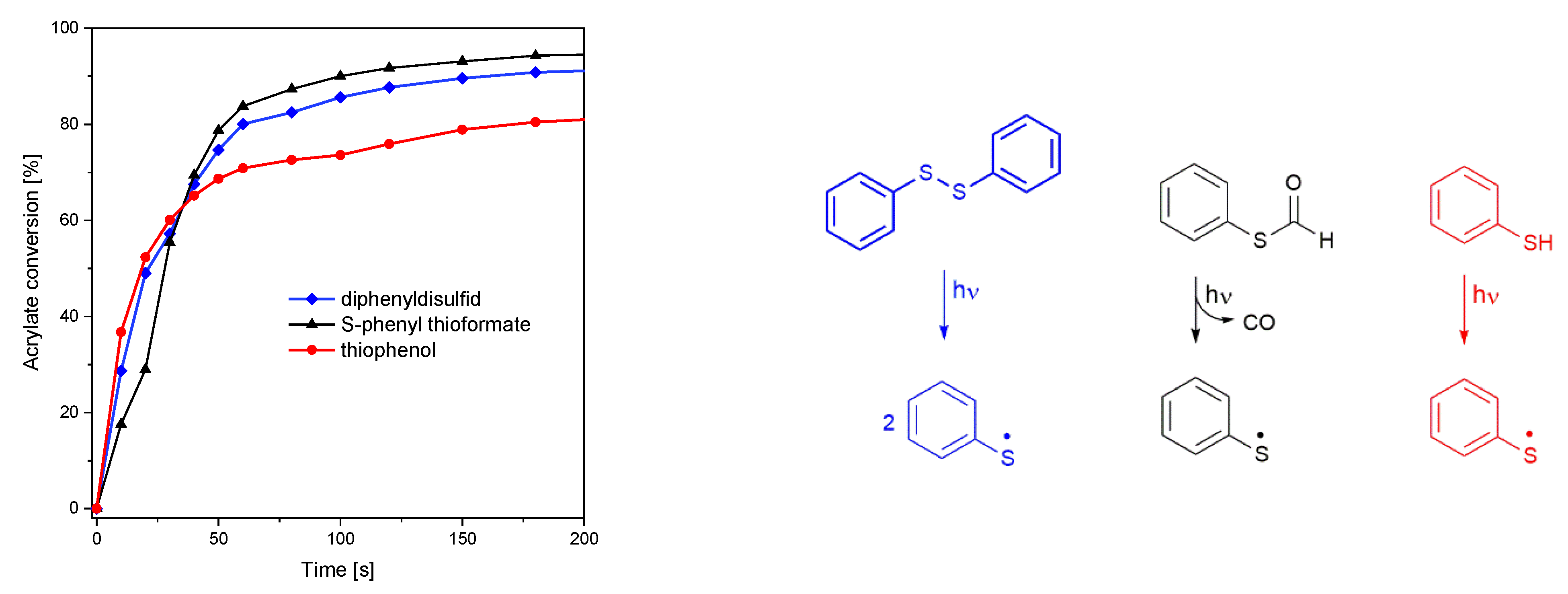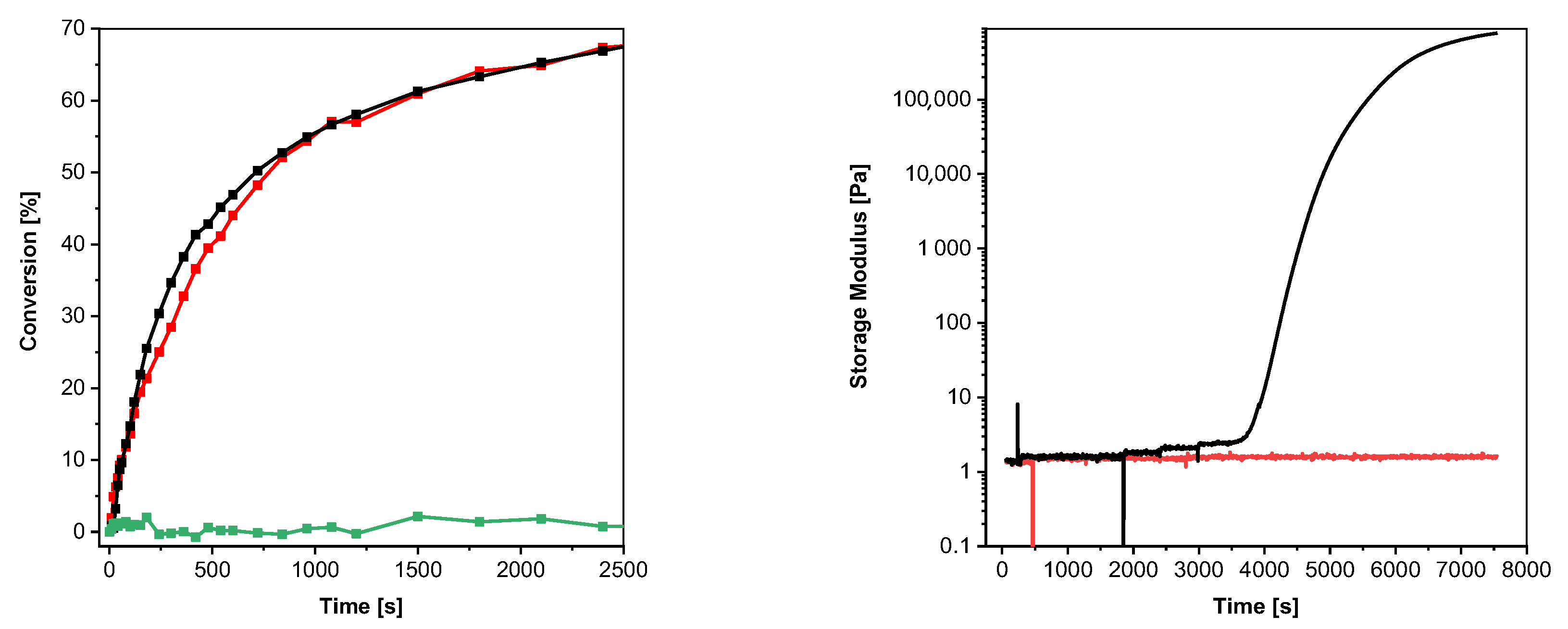Exploring Aromatic S-Thioformates as Photoinitiators
Abstract
1. Introduction
2. Results and Discussion
2.1. Photoreactivity of S-Phenyl Thioformate
2.2. Photoinitiation of Acrylate Polymerization
2.3. Photoinitiation of Thiol-Methacrylate Polymerization
3. Conclusions
Supplementary Materials
Author Contributions
Funding
Institutional Review Board Statement
Data Availability Statement
Acknowledgments
Conflicts of Interest
References
- Griesser, T.; Wolfberger, A.; Edler, M.; Belzik, M.; Jakopic, G.; Trimmel, G.; Kern, W. UV-induced refractive index modulation of photoreactive polymers bearing N-acylcarbazole groups. J. Polym. Sci. A Polym. Chem. 2010, 48, 3507–3514. [Google Scholar] [CrossRef]
- Höfler, T.; Grießer, T.; Gstrein, X.; Trimmel, G.; Jakopic, G.; Kern, W. UV reactive polymers for refractive index modulation based on the photo-Fries rearrangement. Polymer 2007, 48, 1930–1939. [Google Scholar] [CrossRef]
- Höfler, T.; Grießer, T.; Gruber, M.; Jakopic, G.; Trimmel, G.; Kern, W. Photo-Fries Rearrangement in Polymeric Media: An Investigation on Fully Aromatic Esters Containing the Naphthyl Chromophore. Macromol. Chem. Phys. 2008, 209, 488–498. [Google Scholar] [CrossRef]
- Takahashi, A.; Watanabe, T.; Ando, S.; Kameyama, A. Refractive Index Modulation by Photo-Fries Rearrangement of Main Chain-Type Aromatic Polyurethanes. J. Photopol. Sci. Technol. 2019, 32, 243–247. [Google Scholar] [CrossRef]
- Zhao, J.; Er, G.T.K.; McCallum, F.J.; Wang, S.; Fu, C.; Kaitz, J.A.; Cameron, J.F.; Trefonas, P.; Blakey, I.; Peng, H.; et al. Photo/Thermal Dual Responses in Aqueous-Soluble Copolymers Containing 1-Naphthyl Methacrylate. Macromolecules 2021, 54, 4860–4870. [Google Scholar] [CrossRef]
- Anderson, J.C.; Reese, C.B. A photo-induced rearrangement involving aryl participation. Tetrahedron Lett. 1962, 3, 1–4. [Google Scholar] [CrossRef]
- Ramamurthy, V.; Schanze, K.S. Photochemistry of Organic Molecules in Isotropic and Anisotropic Media; CRC Press: Boca Raton, FL, USA, 2003. [Google Scholar] [CrossRef]
- Grunwell, J.R.; Marron, N.A.; Hanhan, S.I. Photochemistry of aromatic thiol esters. J. Org. Chem. 1973, 38, 1559–1562. [Google Scholar] [CrossRef]
- Lochbrunner, S.; Zissler, M.; Piel, J.; Riedle, E.; Spiegel, A.; Bach, T. Real time observation of the photo-Fries rearrangement. J. Chem. Phys. 2004, 120, 11634–11639. [Google Scholar] [CrossRef]
- Belluš, D.; Sláma, P.; Hrdkovič, P.; Maňásek, Z.; Ďurišinovǎ, L. Photoumlagerung und Photoabbau des Poly(4-benzoyloxystyrols) und Poly(p-kresylacrylats). J. Polym. Sci. C Polym. Symp. 1969, 22, 629–643. [Google Scholar] [CrossRef]
- Li, S.K.L.; Guillet, J.E. Studies of the Photo-Fries Reaction in Solid Poly(phenyl acrylate). Macromolecules 1977, 10, 840–844. [Google Scholar] [CrossRef]
- Griesser, T.; Kuhlmann, J.C.; Wieser, M.; Kern, W.; Trimmel, G. UV-Induced Modulation of the Refractive Index and the Surface Properties of Photoreactive Polymers Bearing N -Phenylamide Groups. Macromolecules 2009, 42, 725–731. [Google Scholar] [CrossRef]
- Frechet, J.M.J.; Tessier, T.G.; Willson, C.G.; Ito, H. Poly[p-(formyloxy)styrene]: Synthesis and radiation-induced decarbonylation. Macromolecules 1985, 18, 317–321. [Google Scholar] [CrossRef]
- Lowe, A.B. Thiol-yne ‘click’/coupling chemistry and recent applications in polymer and materials synthesis and modification. Polymer 2014, 55, 5517–5549. [Google Scholar] [CrossRef]
- Lowe, A.B. Thiol-ene “click” reactions and recent applications in polymer and materials synthesis. Polym. Chem 2010, 1, 17. [Google Scholar] [CrossRef]
- Lowe, A.B.; Hoyle, C.E.; Bowman, C.N. Thiol-yne click chemistry: A powerful and versatile methodology for materials synthesis. J. Mater. Chem. 2010, 20, 4745. [Google Scholar] [CrossRef]
- Cramer, N.B.; Bowman, C.N. Kinetics of thiol-ene and thiol-acrylate photopolymerizations with real-time fourier transform infrared. J. Polym. Sci. A Polym. Chem. 2001, 39, 3311–3319. [Google Scholar] [CrossRef]
- Ye, S.; Cramer, N.B.; Smith, I.R.; Voigt, K.R.; Bowman, C.N. Reaction kinetics and reduced shrinkage stress of thiol–yne–methacrylate and thiol–yne–acrylate ternary systems. Macromolecules 2011, 44, 9084–9090. [Google Scholar] [CrossRef]
- Reddy, S.K.; Cramer, N.B.; Bowman, C.N. Thiol− Vinyl Mechanisms. 2. Kinetic Modeling of Ternary Thiol−Vinyl Photopolymerizations. Macromolecules 2006, 39, 3681–3687. [Google Scholar] [CrossRef]
- Lee, T.Y.; Carioscia, J.; Smith, Z.; Bowman, C.N. Thiol−Allyl Ether−Methacrylate ternary systems. Evolution mechanism of polymerization-induced shrinkage stress and mechanical properties. Macromolecules 2007, 40, 1473–1479. [Google Scholar] [CrossRef]
- Hoyle, C.E.; Lee, T.Y.; Roper, T. Thiol-enes: Chemistry of the past with promise for the future. J. Polym. Sci. A Polym. Chem. 2004, 42, 5301–5338. [Google Scholar] [CrossRef]
- Lowe, A.B. Thiol-X Chemistries in Polymer and Materials Science, 1st ed.; Royal Society of Chemistry: London, UK, 2013. [Google Scholar]
- Lee, T.Y.; Roper, T.M.; Guymon, C.A.; Jonsson, E.S.; Hoyle, C.E. (Eds.) Copolymerization Mechanism of Photoinitiator Free Thiol-Vinyl Acrylate Systems. ACS Symp. Ser. 2006, 941, 17–28. [Google Scholar] [CrossRef]
- Resetco, C.; Hendriks, B.; Badi, N.; Du Prez, F. Thiol–ene chemistry for polymer coatings and surface modification—Building in sustainability and performance. Mater. Horiz. 2017, 4, 1041–1053. [Google Scholar] [CrossRef]
- Hoyle, C.E.; Bowman, C.N. Thiol-ene click chemistry. Angew. Chem. 2010, 49, 1540–1573. [Google Scholar] [CrossRef]
- Love, D.M.; Fairbanks, B.D.; Bowman, C.N. Evaluation of Aromatic Thiols as Photoinitiators. Macromolecules 2020, 53, 5237–5247. [Google Scholar] [CrossRef]
- Kühne, G.; Diesen, J.S.; Klemm, E. New results of the self-initiation mechanism of SH/En addition polymerization. Die Angew. Makromol. Chem. 1996, 242, 139–145. [Google Scholar] [CrossRef]
- Edler, M.; Mostegel, F.H.; Roth, M.; Oesterreicher, A.; Kappaun, S.; Griesser, T. Enhancing the stability of UV-curable thiol/vinyl carbonate resins. J. Appl. Polym. Sci. 2017, 134, 2237. [Google Scholar] [CrossRef]
- Haraguchi, R.; Tanazawa, S.G.; Tokunaga, N.; Fukuzawa, S.I. Palladium-Catalyzed Formylation of Arylzinc Reagents with S-Phenyl Thioformate. Org. Lett. 2017, 19, 1646–1649. [Google Scholar] [CrossRef] [PubMed]
- Ito, O.; Matsuda, M. Flash Photolysis Study for Substituent and Solvent Effects on Spin-trapping Rates of Phenylthiyl Radicals with Nitrones. BCSJ 1984, 57, 1745–1749. [Google Scholar] [CrossRef]
- Bauer, N.A.; Hoque, E.; Wolf, M.; Kleigrewe, K.; Hofmann, T. Detection of the formyl radical by EPR spin-trapping and mass spectrometry. Free. Radic. Biol. Med. 2018, 116, 129–133. [Google Scholar] [CrossRef]
- Buettner, G.R. Spin trapping: ESR parameters of spin adducts. Free. Radic. Biol. Med. 1987, 3, 259–303. [Google Scholar] [CrossRef]
- Esfandiari, P.; Ligon, S.C.; Lagref, J.J.; Frantz, R.; Cherkaoui, Z.; Liska, R. Efficient stabilization of thiol-ene formulations in radical photopolymerization. J. Polym. Sci. A Polym. Chem. 2013, 51, 4261–4266. [Google Scholar] [CrossRef]





Disclaimer/Publisher’s Note: The statements, opinions and data contained in all publications are solely those of the individual author(s) and contributor(s) and not of MDPI and/or the editor(s). MDPI and/or the editor(s) disclaim responsibility for any injury to people or property resulting from any ideas, methods, instructions or products referred to in the content. |
© 2023 by the authors. Licensee MDPI, Basel, Switzerland. This article is an open access article distributed under the terms and conditions of the Creative Commons Attribution (CC BY) license (https://creativecommons.org/licenses/by/4.0/).
Share and Cite
Rieger, P.; Pueschmann, S.; Haas, M.; Schmallegger, M.; Guedes de la Cruz, G.; Griesser, T. Exploring Aromatic S-Thioformates as Photoinitiators. Polymers 2023, 15, 1647. https://doi.org/10.3390/polym15071647
Rieger P, Pueschmann S, Haas M, Schmallegger M, Guedes de la Cruz G, Griesser T. Exploring Aromatic S-Thioformates as Photoinitiators. Polymers. 2023; 15(7):1647. https://doi.org/10.3390/polym15071647
Chicago/Turabian StyleRieger, Paul, Sabrina Pueschmann, Michael Haas, Max Schmallegger, Gema Guedes de la Cruz, and Thomas Griesser. 2023. "Exploring Aromatic S-Thioformates as Photoinitiators" Polymers 15, no. 7: 1647. https://doi.org/10.3390/polym15071647
APA StyleRieger, P., Pueschmann, S., Haas, M., Schmallegger, M., Guedes de la Cruz, G., & Griesser, T. (2023). Exploring Aromatic S-Thioformates as Photoinitiators. Polymers, 15(7), 1647. https://doi.org/10.3390/polym15071647







